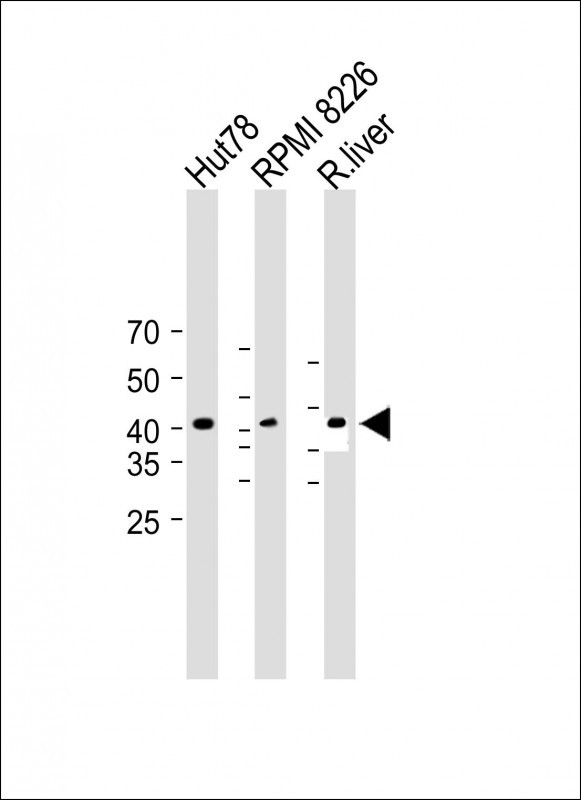FUT7 Antibody (N-term)
Affinity Purified Rabbit Polyclonal Antibody (Pab)
- 产品详情
- 实验流程
- 背景知识
Application
| WB, E |
|---|---|
| Primary Accession | Q11130 |
| Other Accession | NP_004470.1 |
| Reactivity | Human, Rat, Mouse |
| Host | Rabbit |
| Clonality | Polyclonal |
| Isotype | Rabbit IgG |
| Calculated MW | 39239 Da |
| Antigen Region | 78-106 aa |
| Gene ID | 2529 |
|---|---|
| Other Names | Alpha-(1, 3)-fucosyltransferase 7, 241-, Fucosyltransferase 7, Fucosyltransferase VII, Fuc-TVII, FucT-VII, Galactoside 3-L-fucosyltransferase, Selectin ligand synthase, FUT7 |
| Target/Specificity | This FUT7 antibody is generated from rabbits immunized with a KLH conjugated synthetic peptide between 78-106 amino acids from the N-terminal region of human FUT7. |
| Dilution | WB~~1:1000 E~~Use at an assay dependent concentration. |
| Format | Purified polyclonal antibody supplied in PBS with 0.05% (V/V) Proclin 300. This antibody is prepared by Saturated Ammonium Sulfate (SAS) precipitation followed by dialysis against PBS. |
| Storage | Maintain refrigerated at 2-8°C for up to 2 weeks. For long term storage store at -20°C in small aliquots to prevent freeze-thaw cycles. |
| Precautions | FUT7 Antibody (N-term) is for research use only and not for use in diagnostic or therapeutic procedures. |
| Name | FUT7 (HGNC:4018) |
|---|---|
| Function | Catalyzes the transfer of L-fucose, from a guanosine diphosphate-beta-L-fucose, to the N-acetyl glucosamine (GlcNAc) of a distal alpha2,3 sialylated lactosamine unit of a glycoprotein or a glycolipid-linked sialopolylactosamines chain through an alpha-1,3 glycosidic linkage and participates in the final fucosylation step in the biosynthesis of the sialyl Lewis X (sLe(x)), a carbohydrate involved in cell and matrix adhesion during leukocyte trafficking and fertilization (PubMed:11404359, PubMed:15632313, PubMed:15926890, PubMed:18402946, PubMed:18553500, PubMed:29593094, PubMed:8207002, PubMed:8666674, PubMed:8752218, PubMed:9299472, PubMed:9405391, PubMed:9461592, PubMed:9473504, PubMed:9499379). In vitro, also synthesizes sialyl-dimeric-Lex structures, from VIM-2 structures and both di-fucosylated and trifucosylated structures from mono-fucosylated precursors (PubMed:9499379). However does not catalyze alpha 1-3 fucosylation when an internal alpha 1-3 fucosylation is present in polylactosamine chain and the fucosylation rate of the internal GlcNAc residues is reduced once fucose has been added to the distal GlcNAc (PubMed:9473504, PubMed:9499379). Also catalyzes the transfer of a fucose from GDP-beta-fucose to the 6-sulfated a(2,3)sialylated substrate to produce 6-sulfo sLex mediating significant L-selectin- dependent cell adhesion (PubMed:10200296, PubMed:8752218). Through sialyl-Lewis(x) biosynthesis, can control SELE- and SELP-mediated cell adhesion with leukocytes and allows leukocytes tethering and rolling along the endothelial tissue thereby enabling the leukocytes to accumulate at a site of inflammation (PubMed:10386892, PubMed:29138114, PubMed:8666674, PubMed:9473504, PubMed:9834120). May enhance embryo implantation through sialyl Lewis X (sLeX)-mediated adhesion of embryo cells to endometrium (PubMed:18402946, PubMed:18553500). May affect insulin signaling by up-regulating the phosphorylation and expression of some signaling molecules involved in the insulin-signaling pathway through SLe(x) which is present on the glycans of the INSRR alpha subunit (PubMed:17229154). |
| Cellular Location | Golgi apparatus, Golgi stack membrane; Single- pass type II membrane protein. Note=Membrane-bound form in trans cisternae of Golgi |
| Tissue Location | Leukocytic/myeloid lineage cells. |
For Research Use Only. Not For Use In Diagnostic Procedures.
Provided below are standard protocols that you may find useful for product applications.
BACKGROUND
The protein encoded by this gene is a Golgi stack membrane protein that is involved in the creation of sialyl-Lewis X antigens. The encoded protein can direct the synthesis of the E-selectin-binding sialyl-Lewis X moiety.
REFERENCES
Li, W., et al. Oncol. Rep. 23(6):1609-1617(2010)
Yoshida, T., et al. Int. J. Mol. Med. 25(4):649-656(2010)
Oguri, M., et al. Am. J. Hypertens. 23(1):70-77(2010)
Zhang, Y., et al. Fertil. Steril. 91(3):908-914(2009)
Wang, Q.Y., et al. J. Cell. Biochem. 104(6):2078-2090(2008)
终于等到您。ABCEPTA(百远生物)抗体产品。
点击下方“我要评价 ”按钮提交您的反馈信息,您的反馈和评价是我们最宝贵的财富之一,
我们将在1-3个工作日内处理您的反馈信息。
如有疑问,联系:0512-88856768 tech-china@abcepta.com.























 癌症的基本特征包括细胞增殖、血管生成、迁移、凋亡逃避机制和细胞永生等。找到癌症发生过程中这些通路的关键标记物和对应的抗体用于检测至关重要。
癌症的基本特征包括细胞增殖、血管生成、迁移、凋亡逃避机制和细胞永生等。找到癌症发生过程中这些通路的关键标记物和对应的抗体用于检测至关重要。 为您推荐一个泛素化位点预测神器——泛素化分析工具,可以为您的蛋白的泛素化位点作出预测和评分。
为您推荐一个泛素化位点预测神器——泛素化分析工具,可以为您的蛋白的泛素化位点作出预测和评分。 细胞自噬受体图形绘图工具为你的蛋白的细胞受体结合位点作出预测和评分,识别结合到自噬通路中的蛋白是非常重要的,便于让我们理解自噬在正常生理、病理过程中的作用,如发育、细胞分化、神经退化性疾病、压力条件下、感染和癌症。
细胞自噬受体图形绘图工具为你的蛋白的细胞受体结合位点作出预测和评分,识别结合到自噬通路中的蛋白是非常重要的,便于让我们理解自噬在正常生理、病理过程中的作用,如发育、细胞分化、神经退化性疾病、压力条件下、感染和癌症。






